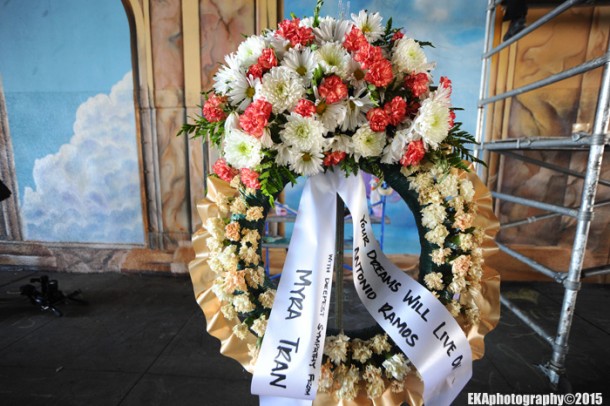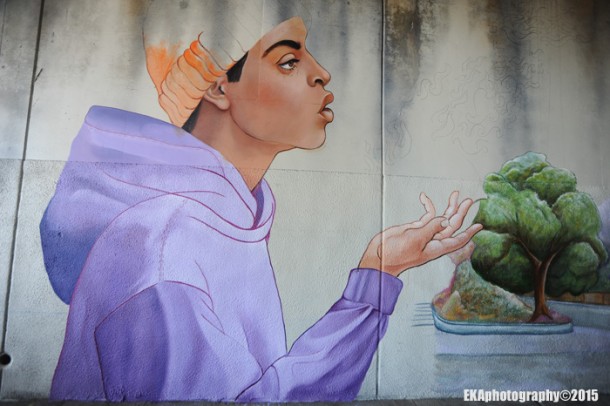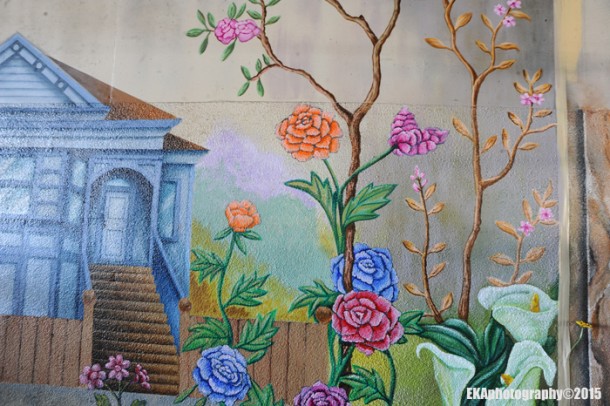
It’s the worst-case scenario for a mural artist: to be the victim of deadly violence while painting on public streets. But the muralists who witnessed the shooting death of Antonio Ramos say the tragic incident may have been shocking and horrific, but hasn’t deterred them from continuing to work on the third installment in the “Oakland Superheroes” series being painted under freeway overpasses in West Oakland.
“Public art… is a powerful way to engage the public,” said Amana Harris, Executive Director of non-profit organization Attitudinal Healing Connection, who produced the mural series. “On a pure aesthetic level, what these murals do is amazing. What happens when you bring color into these dull, blighted, neglected areas? … The mural brings energy and attention into these spaces that we typically ignore.”
Ironically, Harris added, “this is the exact kind of thing our superheroes, our young people, are addressing – they’re addressing shooting, and homelessness, and waste. My hope is it will put attention to some of the problems we have in our community, cultivating young people.”

As CRP founder and Executive Director Desi Mundo said, “the tragic murder of Antonio Ramos really hit home for CRP. Those bullets could have easily hit CRP’s Pancho Peskador, who was painting with Ramos and AHC artists when the gunman fired. Moreover, CRP’s holistic mural efforts have frequently taken us into similar situations in at-risk neighborhoods. For instance, we were painting a Silence the Violence mural on 60th and MacArthur when rapper Kafani was shot four times just a few blocks away. Muralists are naturally on the frontlines in the community.”
Harris said that each “Superheroes” mural was conceived with the help of students at local schools – in this case, West Oakland Middle School. The process employs the self-as-superhero curriculum Harris developed, which involves “young people coming up with stories about how they want to solve problems in their community.” After a site visit where the youths’ ideas are gathered, the lead artist creates a sketch. Local artists are then hired to paint the final design.

Ramos was one of those artists, Harris said. “He was drawn to this process, she recalled. ”He was in the community, he saw what was happening, he was interested, he had the talent and became engaged.”
On Oct. 29, at about 1030 am, Ramos was taking pictures of the in-progress painting, witnesses say, when the incident occurred. According to lead artist and designer Javier Rocabado, “I saw a man coming this way in a black Adidas jumpsuit. He damaged the mural and Antonio asked him why he did that. The guy never responded, he just came back and shot him. There was no exchange of words, it was just a random act of violence.”
“It wasn’t an argument. It wasn’t yelling or screaming,” Peskador noted. “The dude just turned around and took his pistol out of his underpants. He was so cold-blooded. He pulled out the gun, point at him, shoot at him once, turned around and left walking.”

As Art Director David Burke explained, ”the wall’s 200 feet long, we have 10-12 artists who are spread out along the wall. I was at the far end of the wall. I heard the shot. I turned, and I found Antonio lying in the street. We got him out of the street, the team worked to stabilize him and just try to keep him stable until the police and the paramedics responded.”
The muralists initially loaded Ramos into a pickup truck, to try to take him to the hospital. Police arrived within five or six minutes, however, and prevented them from moving the body while they waited for paramedics to arrive. The wait seemed indeterminable for Ramos’ friends and colleagues. “His soul was leaving his body,” Peskador recalled, adding, “I was really disappointed how the police handled everything,” he said.
After getting a tip on the whereabouts of the shooter from a motorist who tailed the man to a nearby location, Peskador said he attempted to pass that information to the officers, but was told to wait until they asked him for it. An hour later, the officers took his statement. ”By then it was too late,” he observed. Two weeks later, he said, no one from OPD has followed up with him.

Ramos’ death resulted in a plethora of news reports from local and even national outlets, including at least four separate reports by Channel 7 – another irony, Harris says, since prior to the incident there was little media interest in covering the mural project. “AHC has been trying for months and months to get the media to cover the positive stories,” she noted. “Our culture is drawn toward these violent events… there are so many people in this city doing amazing things. We need to hear more about that too.”
Harris was particularly critical of a New York Times article which insisted Oakland was “enjoying a gentrification boom but still bogged down by crime” – an assertion at odds with quoted comments in that same article by police chief Sean Whent, who hinted that gentrification could actually be a cause of crime: “People are worried about gentrification because… it does enhance conflict.”
The notion that “gentrification is making Oakland better” is a false narrative, Harris said, and one that misses the entire point of the Superheroes project, which is “really about revitalizing our communities from the inside out” using murals as a vehicle for community transformation.

That’s different, she said, from public art which is disconnected from the communities it purportedly serves. “So often, we have people who are not from here who come into our communities doing public artworks. Oftentimes, when the people from the community are trying to help the community, there’s not a big light on that.”
Harris and the mural painters all said the incident reveals how exposed and vulnerable muralists who work in frontline communities like West Oakland really are. “Unfortunately we had to come up close and personal to the trauma that’s happening in our communities all over the world,” Harris said. “All street artists, all public artists who are out there working on walls … we have an unspoken contract with the community,” Burke added. “We have an unspoken agreement we’ll be respected and protected. That’s jarring and unsettling not just for every artist on this wall but, for all street artists across the country.”
“These murals from the beginning have been about promoting peace and love and breaking the cycle of violence in our communities,” Burke said. Ramos’ death “reinforces that narrative,” he stated, adding the mural has now become “a symbol of healing for the community.”

The tragedy highlights largely-unsung, and sometimes dangerous, role muralists can play in rejuvenating neighborhoods without displacing residents. And it speaks to the value of the holistic murals and extensive community engagement process utilized by organizations like CRP, AHC, Trust Your Struggle, and other muralist organizations who are invested in the communities they work in.
But Mundo said it also points to a need for “more significant investment in the arts,” to ensure artists aren’t excluded from neighborhood development plans, have affordable housing and health care, and are fully supported by the city (Oakland currently has no Cultural Arts Commission, and its Cultural Affairs Department has gone from 21 staffers in 2000 to just 1.5 FTE units currently).
For Peskador, the shooting represented a “reality check,” but even though the experience was traumatic for him, he said, “I always have faith that art and murals do change the spaces. Nothing will stop me to keep changing communities and working for the communities. My commitment is even stronger now.”
